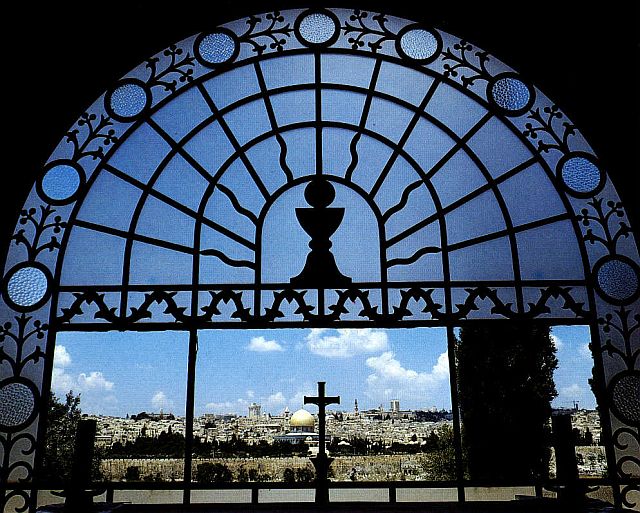
I HAVE visited more than a few gardens, and have written about some of them. There were large public gardens where plants are grown to be studied, and other smaller personal gardens.
What, if anything, do gardens tell us? Isn’t it nothing more than a patch of land where plants, herbs, flowers or vegetables are grown and cared for by a gardener?
Last week I visited a special ground once dominated with olive trees, a natural grotto next to the Tomb of Mary and her Assumption. There are only eight remaining trees— silent witnesses to the Man who once prayed and suffered the night before His crucifixion. I took the road from the Mount of Olives overlooking the city
of Jerusalem to reach Gatshemanim. This is a steep narrow road winding down and leading to the Garden of Olives in
the Basilica of the Agony. Jesus is believed to have come to this place and wept over Jerusalem.
At the Sanctuary of Dominus Flavit is a beautiful panoramic view of the city, with domes dominating the scene. The most dominant is called the Dome of the Rock, a large golden dome that is a holy shrine for the Muslims. It’s the place where Abraham sacrificed his son Isaac. There| is also a black dome of the Church of the Holy Sepulcher where the tomb of Jesus is enshrined next to the 15 steps which was once Mt. Calvary, and many other smaller domes all within the walled old city.
The walled city is divided between the Arabs, the Jews, thus the Wailing Wall so named by the British, and the Christians. The Christian quarter is subdivided as well by the Coptic, Greek and Russian Orthodox, Ethiopian, Armenian and Lutherans.
A few meters away from the sanctuary is a Jewish cemetery facing the city. It is said to be the most expensive cemetery in all of Israel. The cemetery on the slopes facing the east towards Jerusalem have stones instead of flowers adorning the graves—a sight that reminded me of the final scene in the movie “Schindler’s List.”
The stones left by families, relatives, and friends were to be used in rebuilding of the temple.
Today, the Jews want the Promised Land, at which they can build the promised temple. Unfortunately the Muslims have built these mosques on the same spot for more than a thousand years. One need not look any further to understand the conflict in the area in social and political conditions. As I sat in the chapel fashioned like a teardrop facing the altar, there is a large clear glass overlooking the whole city. I now know why Jesus wept over Jerusalem.
The descent from the Mt. of Olives is a 10- to 15-minute walk. I took my time, remembering every detail of the Palm Sunday Road as the locals call it. This road leads to the foot of the Mt. of Olives to the Basilica of the Agony. The basilica was built to recall how Jesus agonized over us to the point of perspiring blood. The present basilica also named the Church of All Nations is the third basilica built on the same site. Contributions for the construction came from different nations for the rebuilding which started in 1919 and completed in 1924.
Its windows created of alabaster filter natural light to be concentrated towards the altar. It creates a prayerful mood and invites the visitor to prostrate at the Rock of Agony, as Jesus did. The two older basilicas, the Byzantine Basilica built in 380 A.D. and the Crusader Basilica constructed in the 12th century were destroyed.
Upon entering the Basilica grounds, one is immediately greeted by gnarled trunks of old olive trees. Cared and preserved by the Franciscan order like most other sites in the Holy Land, through the years its oil is still used and distributed to most Christian churches. Of the eight remaining original olive trees, one is dated to be more two thousand years before the birth of Christ. Another tree was planted by Pope Paul VI on Jan. 4, 1964. Walking inside the fenced garden, one imagines how it felt when Jesus and His disciples stayed for a night before he was betrayed by Judas and handed over to Caiphas and spent another night in the dungeon of the palace.
The garden is a small area designed with pathways perhaps for the gardener to pass through in-between the trees. I approached the altar where one can touch the “rock.” Feeling humbled, I did just that and imagined that somewhere in this part of the white rock polished through the years
Jesus once prayed, along with Peter and the sons of Zebedee.
Towards the end of my visit I found it hard to believe that a garden has no other purpose but beauty alone. Now don’t get me wrong—indeed it is a sight to behold. Gethsemane got its name from Gat + shemanim which means (olive) oil press.
The extraction of the olives here after they are picked, crushed, and pressed is as figurative as I can imagine. Leaving the place, I found the meaning of Gethsemane…
I reflected that some time long ago in the midst of olive trees, Jesus, constrained by our transgressions, experienced much sorrow and distress to the point of sweating blood.